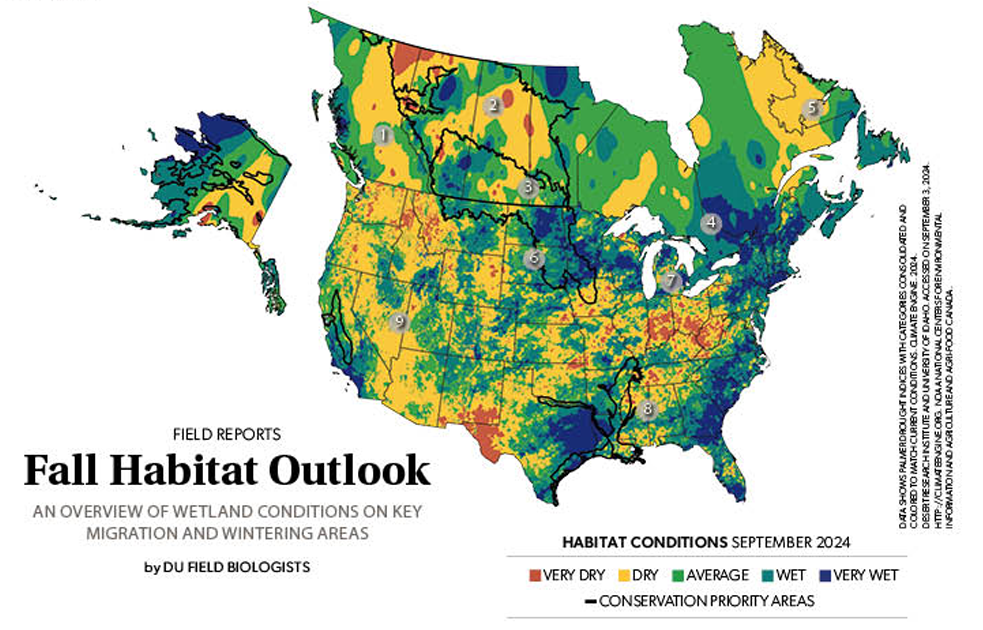Field Reports: 2024 Fall Habitat Outlook
An overview of wetland conditions on key migration and wintering areas
An overview of wetland conditions on key migration and wintering areas

Much of British Columbia remains in the grips of drought. In the interior, late summer rainfall improved soil moisture but water levels remain low in many wetlands. In contrast, the southern coast has received above-average precipitation, providing good habitat for migrating waterfowl. In late September, early arrivals such as American green-winged teal and northern pintails were building on traditional staging areas.
August temperatures were slightly above average across much of the Western Boreal Forest. Despite improvements in parts of the region, water deficits persist in many areas, particularly in northern Saskatchewan and the southern Northwest Territories. The fall migration was well under way in September, with large numbers of waterfowl heading south throughout the region.

After a warm and dry start to summer, much of the region received above-average rainfall in September. Severe to moderate drought persists in small pockets of Alberta and Saskatchewan, but the rest of the region has returned to normal or is only slightly drier than average. In late August, freshly hatched ducklings were still appearing on wetlands as the first sandhill cranes and white-fronted geese were arriving from the north.
Southern Ontario and Quebec experienced a cool, wet summer, while northern and central regions were warmer and drier than average. Most wetlands remain at good levels and will provide favorable habitat for migrating waterfowl. A cold snap in early September triggered the first exodus of Canada geese and blue-winged teal from local wetlands.

Dry weather persisted across much of Atlantic Canada this summer, and water levels have receded in many wetlands. Wild rice and other natural foods are abundant, and corn and other grain crops should provide plenty of foraging opportunities for migrating dabbling ducks and geese.
Although water levels in northeastern Montana, Minnesota, and the western Dakotas have receded over the summer, the eastern Dakotas have continued to receive regular rainfall, maintaining good wetland conditions. An exceptional year for grass growth in the Dakotas provided excellent upland cover for ground-nesting birds. Field reports indicate that waterfowl numbers are similar to last year while upland birds appear to be more abundant in many areas.
While habitat conditions have improved in portions of the Great Lakes and northeastern states, areas of drought persist in both regions, and heavy precipitation will be needed to recharge wetlands in these areas. In September, field reports indicated that good numbers of blue- and green-winged teal and other migrants were building on traditional staging areas.

Abundant summer rainfall along the Gulf Coast has created average to good marsh conditions for waterfowl in many areas. A notable exception is the central coast of Texas, which has remained dry, and several irrigation districts in this area will not be releasing water this year. Early teal season was good for many hunters, especially in the rice fields. In the Mississippi Alluvial Valley, recent rainfall has improved soil-moisture levels and wetland conditions after a hot, dry summer. In the South Atlantic region, waterfowl habitats are in generally good shape heading into the peak migration period.
Waterfowl migration habitats are in fair to good shape across the West. On the Great Salt Lake, water levels will likely be high enough to provide favorable habitat for waterfowl arriving this fall. In the Central Valley of California, water allocations should be sufficient to flood managed wetlands on public lands, and the rice harvest is progressing well, with some fields already receiving water for straw decomposition.

Ducks Unlimited uses cookies to enhance your browsing experience, optimize site functionality, analyze traffic, and deliver personalized advertising through third parties. By continuing to use this site, you agree to our use of cookies. View Privacy Policy